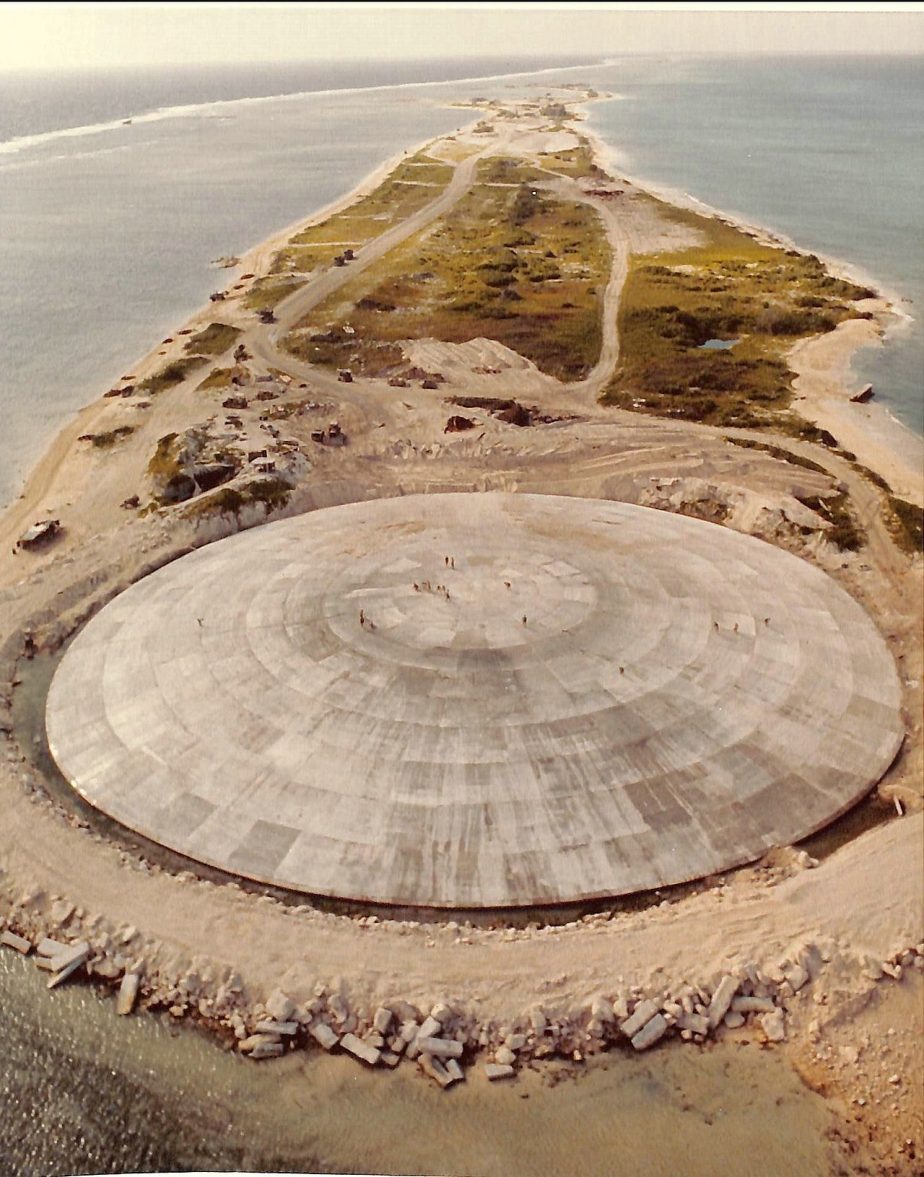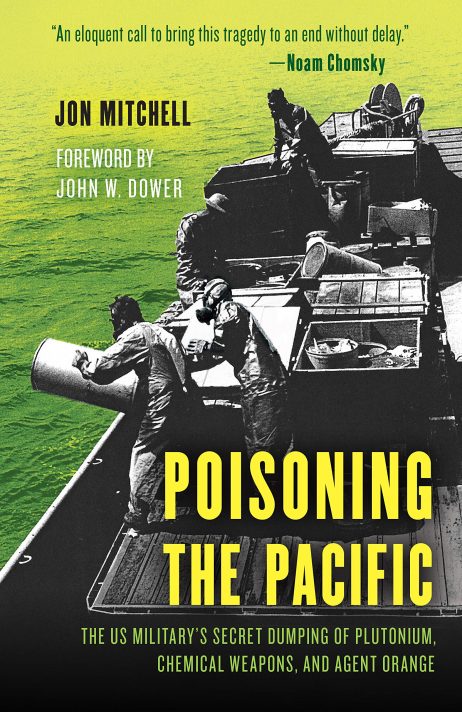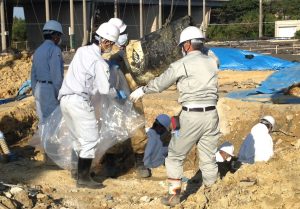The U.S. military presence in the Pacific is generally discussed in terms of geopolitics and strategy. Less prominent are analyses of the human and environmental impact of U.S. military bases and weapons tests. Jon Mitchell, a Japan-based journalist, has long investigated precisely those problems. Mitchell, the author of three Japanese-language books on military contamination outlines the environmental impact of the U.S. post-war military presence in his new book, “Poisoning the Pacific.” The Diplomat’s Shannon Tiezzi interviewed Mitchell about his book, the history of military contamination in the Pacific, and what can be done going forward.
Your book touches on several different kinds of environmental toxins linked to the United States’ military presence in the Pacific: chemical and biological weapons, nuclear contamination (whether from purposeful nuclear tests or accidental damage), and environmental contamination from more routine chemicals stored in U.S. military facilities. Can you give a brief run-down of how the post-war U.S. military presence wound up “poisoning the Pacific”?
During World War II, many islands in the Western Pacific experienced brutal occupation by the Japanese military, notably Guam, the Marshall Islands and Okinawa where — although technically a part of Japan — in the spring of 1945, Imperial Army troops slaughtered civilians during the Battle of Okinawa. The U.S. military stormed these islands at a massive loss of life for Americans and local residents; following the end of fighting, many islanders were grateful to the United States and they looked forward to receiving its constitutional rights. But instead of liberation, they found themselves administered as “territories” or “trusteeships” (the word “colony” is anathema to many Americans) without the rights guaranteed full-fledged states. The U.S. military seized large tracts of indigenous land and, lacking legal protections, residents were powerless to prevent it.
In many cases, the United States used this stolen land to test weapons of mass destruction. In the Marshall Islands, between 1946 and 1958, it conducted 67 nuclear tests, spreading radioactive fallout as far away as Guam and exposing tens of thousands of residents. On Okinawa, the United States packed its bases with one of the planet’s largest stockpiles of weapons of mass destruction — 1000+ nuclear warheads, hundreds of thousands of chemical weapons — and Pentagon scientists there also experimented with biological weapons on rice fields and established a test site for its infamous Project 112 human trials.
In addition to weapons of mass destruction, the region has been contaminated by seven decades of conventional military operations, including spills and dumps of fuel, pesticides, per- and polyfluoroalkyl substances (PFAS), asbestos, and lead. Such pollution has occurred on bases within the United States, too, but as far as Japan is concerned, the difference lies in its remediation. Whereas the Department of Defense and Environmental Protection Agency investigate, make public, and clean up such contamination in the United States, Japanese authorities are not allowed to enter the bases here to check for pollution.
As a journalist, it’s my job to investigate and inform the public about what goes on behind the fences. My main tools are (1) interviewing people with close knowledge of the bases – veterans, whistleblowers and local base workers; and (2) using the U.S. Freedom of Information Act to obtain records from federal government agencies. To promote transparency and help the thousands of people sickened by contamination, I’ve donated these documents to universities in Japan and the United States, and uploaded them to my publisher’s homepage.
The nature of the contamination depends heavily on the nature of the U.S. presence. Which countries or areas have been the worst affected, and has there been any attempt at remediation (whether by local governments alone or with U.S. cooperation)?
On mainland Asia, the worst affected countries have been Vietnam, Laos, and Cambodia. Between 1962 and 1971, the United States sprayed the region with tens of millions of liters of dioxin-tainted herbicides, including the most infamous, Agent Orange. Today, approximately three million Vietnamese are suffering from the effects of this exposure; likewise, hundreds of thousands of American service members have been sickened, too. In Vietnam, the U.S. government has been cleaning up the worst contaminated sites but it doesn’t pay for health care or reparations to the sick. Because the spraying of Laos and Cambodia was conducted by the CIA, we still don’t know the extent of the damage there; moreover, Laos still has approximately 80 million U.S. unexploded munitions, roughly ten per person.

Between 1977 and 1980, 4000 US soldiers packed radioactive waste into a nuclear crater on Runit Island then capped it with concrete, a structure the U.S. government promised would last 200,000 years – but today it is already leaking. Photo by the U.S. Department of Defense.
In the Marshall Islands, where the United States detonated the equivalent of more than ten Hiroshima-sized bombs a week for a dozen years, the explosions were so destructive that regional maps had to be redrawn because some small islands had been vaporized. The American Cancer Society has called cancer rates in the region “extreme” and birth defects – so-called “jellyfish babies” – have been common. In the 1970s, to fend off a lawsuit from islanders, the United States promised to clean up its radioactive waste but its operation was slipshod. It dumped 110,000 tons of radioactive soil into a bomb crater on Runit Island then capped it with concrete slabs, promising it would stay safe for two hundred thousand years – but it’s already leaking. Even though many of the soldiers who carried out the work fell sick, the government has denied them compensation. As my book explains, the same appalling pattern is repeated again and again: the DoD orders service members to handle extremely hazardous substances then it refuses to help them when they become ill.
On Okinawa, the human impact of military contamination has been acute but most people outside the island remain unaware. My book details deaths and illnesses among civilians dating from just after the end of World War II to the present day. Worst affected have been Okinawan children – exposed in their classrooms to leaks of CS gas, burned while swimming near shorelines sprayed with defoliants, and sickened by herbicides in their drinking water. Because the Japanese government hasn’t conducted any epidemiological studies on communities living near the bases, only now are we beginning to understand the long term health damage, particularly from the PFAS contamination of water sources – a problem which is still ongoing today.
Accompanying the health impact on Okinawa, there has also been severe economic damage. Under U.S.-Japan bilateral agreements when base land is returned to civilian use, the cost of clean-ups is fully paid by Japanese tax payers; since 2003, this figure has reached approximately 13 billion yen. Military contamination also slows down redevelopment projects. Many people retain the outdated belief that Okinawa would not be able to survive financially without the military presence. But the reverse is true: the U.S. military hobbles economic growth. Bases occupy 15 percent of Okinawa’s main island but contribute only 5 percent to the prefectural economy.
Most U.S. readers would likely be shocked by the revelations you make. To what extent are local communities in, say, Okinawa or Guam, aware of the environmental damage done and the connection to U.S. military installations? Where local communities are aware of the problem, are there movements to demand compensation? Have there been any success stories so far?
Since its atomic bombings of Hiroshima and Nagasaki, the United States has tried to cover up the health and environmental impact of military toxins, such as Agent Orange, depleted uranium, and PFAS. Repeatedly, the Department of Defense, State Department, and CIA have hidden the truth, lied, and disparaged journalists investigating the problem. I’ve experienced this pushback directly, for example, the U.S. Air Force blocked my internet service provider and the State Department interfered with a public lecture I was giving in Tokyo.
Although “Poisoning the Pacific” is the first time much of my research has been published in English, I’ve been reporting about military contamination for the Japanese-language media for the past five years and I’ve written three bestselling Japanese books. Due to this, many mainland Japanese people are now becoming aware of the environmental damage caused by military operations.
On Okinawa, people have long understood how the U.S. military has poisoned their communities. In 1969, a leak of nerve agent near Kadena Air Base sparked mass demonstrations and the current contamination of the island’s drinking water is causing similar outrage – Governor Denny Tamaki even cited the problem in this year’s speech on the 75th anniversary of the Battle of Okinawa.
On Guam, there is widespread awareness of the environmental impact of the military and many of the island’s elected officials stridently speak out against the damage to their island. Likewise, in the Marshall Islands – where the U.S. continues to test nuclear rockets at Kwajalein – residents have repeatedly demanded the Department of Defense be held to account for regional destruction. Campaigns against military contamination in the Pacific are part of the wider struggle for environmental justice encompassing indigenous people’s protests against the Dakota Access Pipeline on Sioux tribal land and the construction of the Thirty Meter Telescope at Mauna Kea, Hawai’i.
 As analysts warn of a new cold war between the U.S. and China, we could see the U.S. military presence in the Pacific increase. What steps should be taken to prevent repeating the deadly environmental mistakes of the past?
As analysts warn of a new cold war between the U.S. and China, we could see the U.S. military presence in the Pacific increase. What steps should be taken to prevent repeating the deadly environmental mistakes of the past?
“Poisoning the Pacific” highlights how military environmental damage is not only an American problem – all countries’ militaries contaminate. Residents in colonies and indigenous peoples are often the worst impacted. China exposed hundreds of thousands of Uyghur Muslims during its nuclear weapon detonations at Lop Nur. The British tested mustard agent on Indians and detonated atomic bombs in Australia. France was so adamant of its right to conduct nuclear tests in French Polynesia that, in 1985, it blew up Greenpeace’s Rainbow Warrior to stop it from monitoring its operations.
In the coming years, the Western Pacific and South China Sea will become increasingly militarized by all sides – the United States, China, Japan, the Philippines, Taiwan, and Vietnam. This concentrated presence raises the risks of environmental damage from landfill projects, dumped waste and live-fire training. Accidents will inevitably soar, too. In 2017 alone, U.S. Navy ships from Yokosuka were involved in three major collisions which killed 17 sailors; the following year, NCIS busted an LSD drugs ring among service members assigned to the nuclear reactor division of the USS Ronald Reagan.
But all this pales in comparison to what the impact of an actual conflict would be. In the words of Ui Jun, one of Japan’s leading environmentalists, “War is the ultimate environmental destroyer.”
Despite these fears, there are signs of hope. In January, the Treaty on the Prohibition of Nuclear Weapons (TPNW) will come into force, outlawing the development, testing, production, possession and use of these arms. It ought to renew international understanding of the dangers of these weapons and spur debate about reduction, an important step on the road to their ultimate elimination. Many of the signatories of the TPNW are Pacific nations, highlighting their desire that the rest of the world be spared the suffering which they experienced as test sites during the Cold War.

































